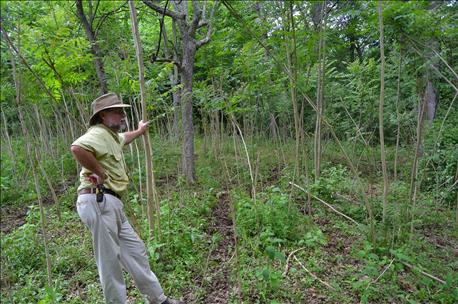
The ground dried out and I saw a dandelion bloom on Feb. 19 this year. We had gotten three days of sun with 60-degree temperatures after having more than four inches of cold rain over a period of two days earlier in the week. Fescue and bluegrass also were green and growing.
We still had enough dry matter to stack up manure piles, however. None of that early spring manure squirting that makes cattle thin. White clover and hairy vetch were starting. Forbs were out of the ground half the size of a coffee cup.

Not so bad: With high stock density, weeds can be an important part of cattle's diet and supply nutrients not present in grasses.
The steers at that time were weighing 750 pounds or better and staying full with two pounds of supplement. We have not fed any hay and at the time I wrote this, we had at least two weeks left before moving to another farm that has been recovering since mid-July.
A ‘no hay’ system ain’t bad.
But I think it might be a good time to mention a few things about specific weeds. I hope that what I am going to say makes sense and is agreeable with at least some of you.
When Oklahoma’s Wally Olsen and wife Doris were here in mid-September we were grazing jungles that had been recovering since early April. Thirty percent or more of the steer’s dry-matter consumption was common ragweed that was blooming and in early seed head development. It was six feet high and nasty, real nasty.
The steers were making good gains. There was lots of grass in the understory but the cattle ended up consuming 60% or more of the forbs. The traps in late February had four to six inches of green fescue and lots of brown litter. This works.
Nature puts forbs (weeds) into our pastures for a good reason. One of our important jobs is to figure out why they are growing. One reason is cattle nutrition. The tap-rooted forbs are often highly nutritious, meaning they are well-mineralized. We have noticed that weeds growing on limestone and high-calcium soils get grazed much harder by cattle. This is not the case where hay rings were used or on hay-feeding sites. I recommend elimination of such sites.
However, spreading (unrolling) of hay, especially on poor ground, is a big soil builder and money maker. We can transform poor sites in two years in areas that receive 40 or more inches of annual moisture with the use of two tools:
1. Unrolled mature C4 hay
2. Cattle in densities of 75,000 pounds or more per acre, that are moved one to five times daily
The weeds are a real aid to the healing of the soil and land. The same is true of brush. The keys are complete plant recovery (lots of carbon), a little lime either applied or fed, unrolling of additional carbon (hay), and short-term, high-density cattle presence. One million or more pounds of cattle per acre for one or more hours can make huge soil impact and spread manure and urine and bring life to near-dead ground and perform miracles. Of any hay fed, 20-70% needs to be trampled and left behind the cattle to quickly heal poor ground.
There are reasons for everything that grows. Declaring war on weeds with chemical and/or clipping is a mistake, most often a big mistake.
Examples in our area are blackberry and raspberry. They quickly come on many sites and in 24 to 36 months can grow thick and seven plus feet in height. They grow 10 to 20 times as much deep diverse root system below the ground as they have growth above the ground. Their leaves and new growth stems are antiparasitical and nutrient dense. The problem is that they shade and take out the grass when they thicken. High animal impact trips their trigger. If the animals remove the leaves twice during the growing season the weeds and brush are dead. Manure and urine from cattle feed bacterial growth in the soil which favors grass in higher densities and percentages.
Planned, short-timed animal density is the cure: The brush (blackberries) get the soil ready and the cattle do the landscaping almost free of charge.
Cattle can be our best tool or our biggest enemy. Time and density are the keys. The decisions and execution is ours.
About the Author(s)
You May Also Like






